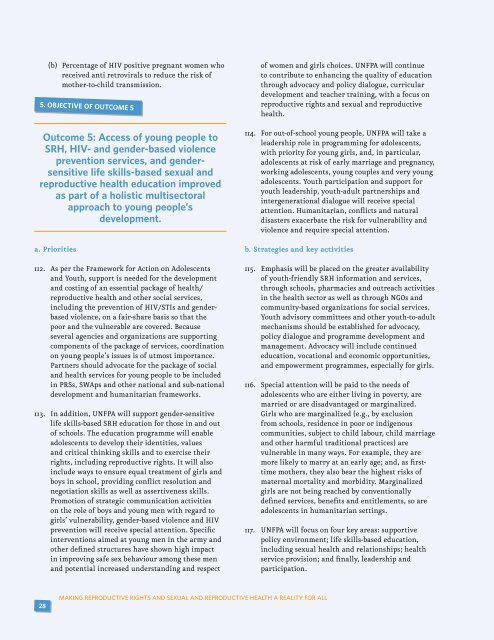Sexual and Reproductive Health Framework - UNFPA
Sexual and Reproductive Health Framework - UNFPA
Sexual and Reproductive Health Framework - UNFPA
Create successful ePaper yourself
Turn your PDF publications into a flip-book with our unique Google optimized e-Paper software.
(b) Percentage of HIV positive pregnant women whoreceived anti retrovirals to reduce the risk ofmother-to-child transmission.5. objective of outcome 5Outcome 5: Access of young people toSRH, HIV- <strong>and</strong> gender-based violenceprevention services, <strong>and</strong> gendersensitivelife skills-based sexual <strong>and</strong>reproductive health education improvedas part of a holistic multisectoralapproach to young people’sdevelopment.a. Priorities112. As per the <strong>Framework</strong> for Action on Adolescents<strong>and</strong> Youth, support is needed for the development<strong>and</strong> costing of an essential package of health/reproductive health <strong>and</strong> other social services,including the prevention of HIV/STIs <strong>and</strong> genderbasedviolence, on a fair-share basis so that thepoor <strong>and</strong> the vulnerable are covered. Becauseseveral agencies <strong>and</strong> organizations are supportingcomponents of the package of services, coordinationon young people’s issues is of utmost importance.Partners should advocate for the package of social<strong>and</strong> health services for young people to be includedin PRSs, SWAps <strong>and</strong> other national <strong>and</strong> sub-nationaldevelopment <strong>and</strong> humanitarian frameworks.113. In addition, <strong>UNFPA</strong> will support gender-sensitivelife skills-based SRH education for those in <strong>and</strong> outof schools. The education programme will enableadolescents to develop their identities, values<strong>and</strong> critical thinking skills <strong>and</strong> to exercise theirrights, including reproductive rights. It will alsoinclude ways to ensure equal treatment of girls <strong>and</strong>boys in school, providing conflict resolution <strong>and</strong>negotiation skills as well as assertiveness skills.Promotion of strategic communication activitieson the role of boys <strong>and</strong> young men with regard togirls’ vulnerability, gender-based violence <strong>and</strong> HIVprevention will receive special attention. Specificinterventions aimed at young men in the army <strong>and</strong>other defined structures have shown high impactin improving safe sex behaviour among these men<strong>and</strong> potential increased underst<strong>and</strong>ing <strong>and</strong> respectof women <strong>and</strong> girls choices. <strong>UNFPA</strong> will continueto contribute to enhancing the quality of educationthrough advocacy <strong>and</strong> policy dialogue, curriculardevelopment <strong>and</strong> teacher training, with a focus onreproductive rights <strong>and</strong> sexual <strong>and</strong> reproductivehealth.114. For out-of-school young people, <strong>UNFPA</strong> will take aleadership role in programming for adolescents,with priority for young girls, <strong>and</strong>, in particular,adolescents at risk of early marriage <strong>and</strong> pregnancy,working adolescents, young couples <strong>and</strong> very youngadolescents. Youth participation <strong>and</strong> support foryouth leadership, youth-adult partnerships <strong>and</strong>intergenerational dialogue will receive specialattention. Humanitarian, conflicts <strong>and</strong> naturaldisasters exacerbate the risk for vulnerability <strong>and</strong>violence <strong>and</strong> require special attention.b. Strategies <strong>and</strong> key activities115. Emphasis will be placed on the greater availabilityof youth-friendly SRH information <strong>and</strong> services,through schools, pharmacies <strong>and</strong> outreach activitiesin the health sector as well as through NGOs <strong>and</strong>community-based organizations for social services.Youth advisory committees <strong>and</strong> other youth-to-adultmechanisms should be established for advocacy,policy dialogue <strong>and</strong> programme development <strong>and</strong>management. Advocacy will include continuededucation, vocational <strong>and</strong> economic opportunities,<strong>and</strong> empowerment programmes, especially for girls.116. Special attention will be paid to the needs ofadolescents who are either living in poverty, aremarried or are disadvantaged or marginalized.Girls who are marginalized (e.g., by exclusionfrom schools, residence in poor or indigenouscommunities, subject to child labour, child marriage<strong>and</strong> other harmful traditional practices) arevulnerable in many ways. For example, they aremore likely to marry at an early age; <strong>and</strong>, as firsttimemothers, they also bear the highest risks ofmaternal mortality <strong>and</strong> morbidity. Marginalizedgirls are not being reached by conventionallydefined services, benefits <strong>and</strong> entitlements, so areadolescents in humanitarian settings.117. <strong>UNFPA</strong> will focus on four key areas: supportivepolicy environment; life skills-based education,including sexual health <strong>and</strong> relationships; healthservice provision; <strong>and</strong> finally, leadership <strong>and</strong>participation.28MAKING REPRODUCTIVE RIGHTS AND SEXUAL AND REPRODUCTIVE HEALTH A REALITY FOR ALL
















